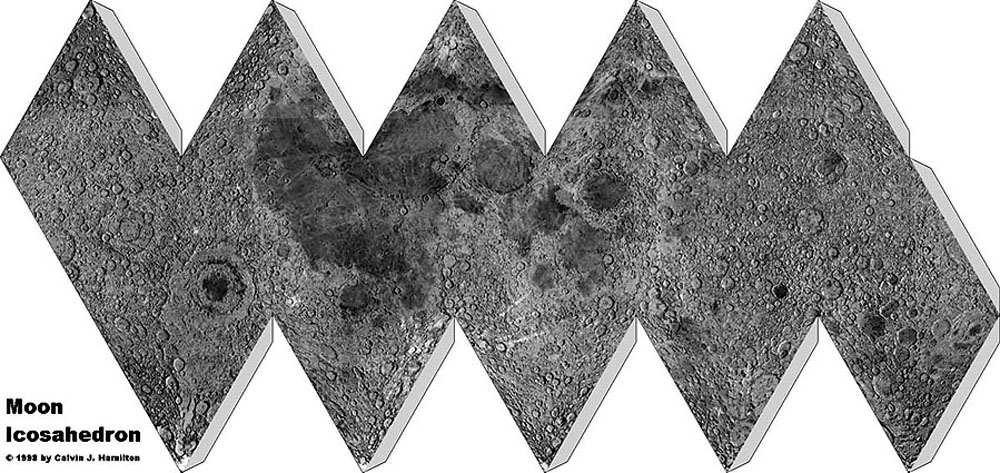Difference between revisions of "February 4, 2010"
(Created page with "__NOTOC__ =Fold a Moon= <!-- ws:start:WikiTextHeadingRule:1:<h1> --> <!-- ws:start:WikiTextLocalImageRule:16:<img src="/file/view/LPOD-Feb4-10.jpeg/117913911...") |
|||
| Line 4: | Line 4: | ||
<!-- ws:start:WikiTextHeadingRule:1:<h1> --> | <!-- ws:start:WikiTextHeadingRule:1:<h1> --> | ||
<!-- ws:start:WikiTextLocalImageRule:16:<img src="/file/view/LPOD-Feb4-10.jpeg/117913911/LPOD-Feb4-10.jpeg" alt="" title="" /> -->[[File:LPOD-Feb4-10.jpeg|LPOD-Feb4-10.jpeg]]<!-- ws:end:WikiTextLocalImageRule:16 --><br /> | <!-- ws:start:WikiTextLocalImageRule:16:<img src="/file/view/LPOD-Feb4-10.jpeg/117913911/LPOD-Feb4-10.jpeg" alt="" title="" /> -->[[File:LPOD-Feb4-10.jpeg|LPOD-Feb4-10.jpeg]]<!-- ws:end:WikiTextLocalImageRule:16 --><br /> | ||
| − | <em>image by [mailto:tychocrater@yahoo.com Chuck Wood]</em><br /> | + | <em>image by [http://planetscapes.com/maps/ico.html Planetary Icosohedrons]</em><br /> |
| + | <br /> | ||
| + | Is it a globe if it has 20 sides? Not really, but its close enough to be a useful 3-D rendition of the Moon. Go to Calvin Hamilton's [http://planetscapes.com/maps/ico.html web site] to download a larger version of this image, and then with, scissors, glue or two-side tape, fold yourself a Moon. Although your Moon will be only 2.75" across, it is large enough to see relationships you miss on a flat map. In fact, even on the unfolded version above you can see that the biggest arc on the Moon isn't the Apennine or Altai mountains, its the shoreline of Oceanus Procellarum. In fact, two scientists independently proposed that Procellarum fills the western half of the Moon's oldest and largest impact basin - Gargantuan. The eastern side of the basin as been disfigured by later forming Imbrium and Serenitatis, but traces of its rim are visible from Sinus Medii to Julius Caesar. Twirl your globe around to look for other surprises! Or revisit the web site to download globes of other planets and moons - you can make your own miniature solar system. And these would be great activities for kids!<br /> | ||
| + | <br /> | ||
| + | <em>[mailto:tychocrater@yahoo.com Chuck Wood]</em><br /> | ||
<em>This is a repeat of the March 21, 2004 LPOD - almost 6 years ago!</em><br /> | <em>This is a repeat of the March 21, 2004 LPOD - almost 6 years ago!</em><br /> | ||
<br /> | <br /> | ||
Revision as of 20:54, 1 January 2015
Fold a Moon
image by Planetary Icosohedrons
Is it a globe if it has 20 sides? Not really, but its close enough to be a useful 3-D rendition of the Moon. Go to Calvin Hamilton's web site to download a larger version of this image, and then with, scissors, glue or two-side tape, fold yourself a Moon. Although your Moon will be only 2.75" across, it is large enough to see relationships you miss on a flat map. In fact, even on the unfolded version above you can see that the biggest arc on the Moon isn't the Apennine or Altai mountains, its the shoreline of Oceanus Procellarum. In fact, two scientists independently proposed that Procellarum fills the western half of the Moon's oldest and largest impact basin - Gargantuan. The eastern side of the basin as been disfigured by later forming Imbrium and Serenitatis, but traces of its rim are visible from Sinus Medii to Julius Caesar. Twirl your globe around to look for other surprises! Or revisit the web site to download globes of other planets and moons - you can make your own miniature solar system. And these would be great activities for kids!
Chuck Wood
This is a repeat of the March 21, 2004 LPOD - almost 6 years ago!
Technical Details
This image is based on the US Geological Survey artistic depiction of the lunar surface, which Calvin Hamilton has replotted to assemble into a folded icosahedron. CAW has darkened and sharpened the image to compensate for reducing the image scale.
Related Links
The Moon
COMMENTS?
Click on this icon File:PostIcon.jpg at the upper right to post a comment.




